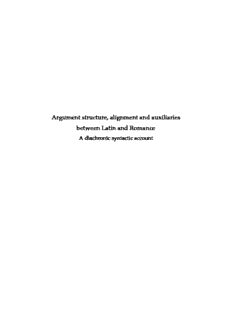Table Of ContentArgument structure, alignment and auxiliaries
between Latin and Romance
A diachronic syntactic account
Published by
LOT phone: +31 30 253 6111
Trans 10
3512 JK Utrecht e-mail: [email protected]
The Netherlands http://www.lotschool.nl
Cover illustration : Veduta di Castro dei Volsci con vigna by
Laura Migliori. All rights reserved.
ISBN: 978-94-6093-209-0
NUR 616
Copyright © 2016: Laura Migliori. All rights reserved.
Argument structure, alignment and auxiliaries
between Latin and Romance
A diachronic syntactic account
Proefschrift
ter verkrijging van de graad van Doctor aan de Universiteit Leiden
op gezag van Rector Magnificus prof. mr. Carel J.J.M. Stolker,
volgens besluit van het College voor Promoties
te verdedigen op woensdag 8 juni 2016
klokke 13.45 uur
door
Laura Migliori
geboren te Rome, Italië
in 1984
Promotiecommissie
Promotores: Prof. dr. Roberta D’Alessandro
Prof. dr. Adam Ledgeway
(University of Cambridge)
Overige leden: Prof. dr. Michela Cennamo
(Università degli Studi di Napoli “Federico II”)
Prof. dr. Johan E.C.V. Rooryck
Dr. Chiara Gianollo (Universität zu Köln)
The research for this dissertation was carried out as part of the VIDI-project
“Splitting and Clustering Grammatical Information”, funded by the
Nederland Organisation for Scientific Research (Nederlandse Organisatie voor
Wetenschappelijk Onderzoek), awarded to Prof. dr. Roberta D’Alessandro
(project number 276-70-021).
Matri patri maioribusque amatissimis
vii
Table of contents
Acknowledgements xi
Abbreviations xiii
Chapter 1: Introduction
1. The Latin language and the definition of alignment 1
2. Alignment, argument structure and auxiliaries
between Latin and Romance 3
3. The Latin language and linguistic studies 4
4. Outline of the present study 7
4.1 Corpus and methodology 7
Chapter 2: The Latin verbal system and the fine structure
of the vP 9
0. Introduction 9
1. Alignment typology and Latin 9
2. Infectum and perfectum 14
3. The occurrence of Latin –r morphology 15
3.1 Active vs. inactive 21
3.2 Latin –r morphology: passives 23
3.3 Latin –r morphology: deponents 24
3.4 Latin deponent verbs 25
3.4.1 Terminology 25
3.4.2 Deponent verbs within the grammatical
discussion 26
3.4.3 Verb types, functions and distribution 28
3.4.3.1 Unaccusatives
(change-of-state and movement verbs) 29
3.4.3.2 Experiential verbs 32
3.4.3.3 Perception verbs 37
3.4.3.4 Other experientials.
Verbs of advantage 38
3.4.3.5 Reciprocals 39
3.4.3.6 Interim conclusions 39
3.5 –r as inactive morphology 40
viii
4. The syntax of Latin –r forms 42
4.1 –r as reflecting different syntactic environments 42
4.1.1 - r morphology as reflecting the [pass] feature 42
4.1.2 –r as reflecting [pass]:
advantages and problems 46
4.2 Different morphology, different argument structure 49
4.2.1 -roles: types and definition 49
4.2.2 -roles: classification and site of assignment 53
4.2.3 Active vs. inactive argument structure 54
4.2.4 The fine structure of vP 58
4.2.5 Argument structure and morphological case 62
4.3 Further evidence 66
4.3.1 Intentionality adverbs 66
4.3.2 Agentive nominalizations 67
4.3.3 No passive form 68
4.4 The analytic perfect reflects an inactive structure 68
5. Possible counterexamples 73
5.1 Deponents + accusative 73
5.2 Present participles 80
5.3 Semi-deponents 81
5.4 Hortor and other verba dicendi 86
5.4.1 Agentive nominalizations 87
5.4.2 Passive forms 87
5.5 Conclusions 88
6. Concluding remarks 88
Chapter 3: Between Latin and Romance: the rise of periphrastic perfects
Synchronic variation and diachronic observations 91
0. Introduction 91
1. The expression of the perfect in Romance 91
1.1 The synthetic-analytic opposition in the Romance
perfect 92
1.2 The diachrony of Romance perfect forms 97
1.3 Auxiliary selection in the perfect: Romance synchronic
variation 99
1.3.1 Pattern 1: one-auxiliary systems 102
1.3.2 Pattern 2: Split Intransitivity 105
1.3.3 Pattern 3: BE/HAVE alternation based on other
factors 109
ix
2. The rise of perfective periphrases in Romance 115
2.1 The limits of the grammaticalization account 115
2.2 The rise of perfective periphrases in Romance:
alignment and auxiliaries 123
2.3 The role of deponent verbs in the change 127
2.3.1 The reanalysis of vP field 132
2.4 Consequences for Romance auxiliation 132
2.5 Diachronic empirical evidence 135
3. The rise of different auxiliation patterns 139
3.1 Split Intransitivity 139
3.1.1 Split Intransitivity: synchrony and
diachrony 142
3.2 BE as the only perfective auxiliary 144
3.3 Synchronic variation as mirror of a diachronic
path 147
3.3.1 The diachrony of auxiliation pattern
in SIDs 149
4. Concluding remarks 157
Chapter 4: Possessive and deontic periphrases between Latin
and Romance 159
0. Introduction 159
1. Possessive constructions 159
1.1 DP possessive constructions in Latin 159
1.2 Possessive periphrastic constructions in Latin 162
1.2.1 The syntax of Latin possessive periphrases 163
1.3 Possessive periphrases between Latin and
Romance 168
1.3.1 Romance outcomes of Latin possessive
periphrases 168
1.3.2 Languages with the HAVE possessive
periphrasis 170
1.3.3 Languages with the BE and the HAVE
possessive periphrases 173
1.4 Possessive periphrases: concluding remarks 177
2. Deontic constructions 178
2.1 Latin deontic periphrases with gerund/gerundive
+ auxiliary 179
2.1.1 Latin gerund and gerundive 181
x
2.1.1.1 Gerund- or gerundive-first
hypothesis? 183
2.1.2 The syntax of Latin deontic constructions
with gerund/gerundive 189
2.2 Deontic periphrases with present infinitive (PI) 193
2.2.1 Auxiliary HABERE + present infinitive 194
2.2.2 Auxiliary ESSE + present infinitive 198
2.3 Deontic constructions between Latin and
Romance 200
2.3.1 Deontic constructions with gerund/
gerundive in Romance 200
2.3.2 PI + HABERE: Romance outcomes 202
2.3.3 PI + ESSE: Romance outcomes 205
2.3.4 Deontic periphrases: concluding remarks 206
3. Some diachronic observations 206
3.1 Some speculations on syntactic change 208
3.2 Conclusions 211
Chapter 5: Conclusions 213
1. The Latin verbal domain 213
2. The development of Romance analytic perfects and of other
periphrases: argument structure and auxiliation 214
3. Concluding remarks and future research 215
References 217
Sources 245
Samenvatting in het Nederlands 247
Curriculum Vitae 253
Description:Alignment, argument structure and auxiliaries between Latin and Romance. 3. 3. The Latin language and linguistic studies. 4. 4. Outline of the present

